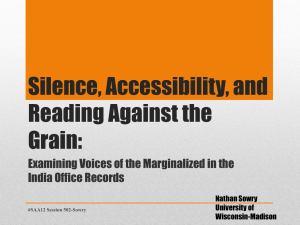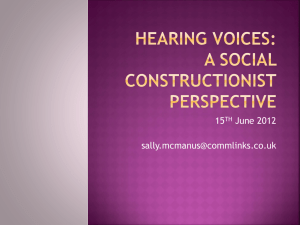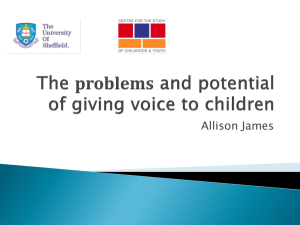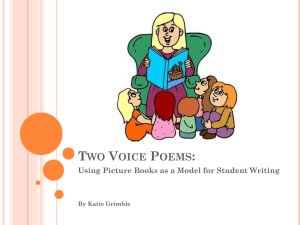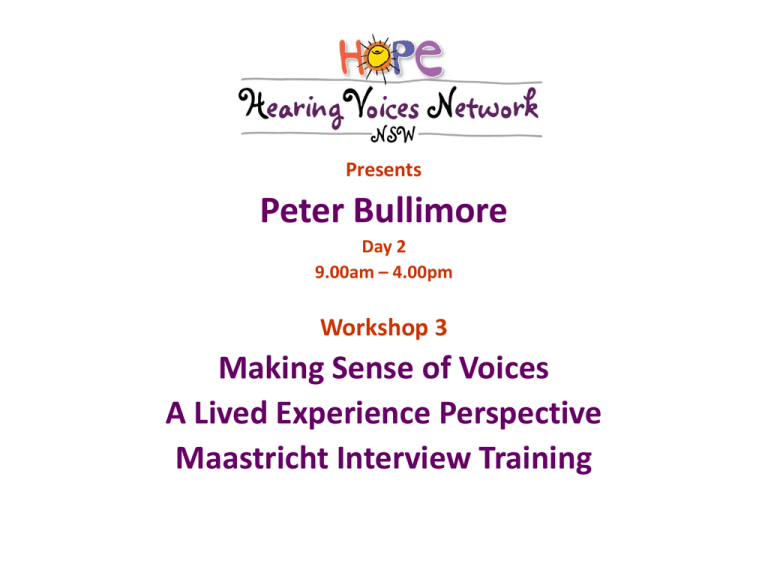
Presents
Peter Bullimore
Day 2
9.00am – 4.00pm
Workshop 3
Making Sense of Voices
A Lived Experience Perspective
Maastricht Interview Training
Using the Maastricht Interview
Introduction
• Workers- tell us a interesting fact about
yourself
• This questionnaire was originally designed as a
research tool to elicit information from people who
hear voices. It has proved to be extremely useful in
getting a much fuller picture of the shared
experiences of voice hearers, and the results have
subsequently been used to develop a range of
coping strategies that can help voice hearers to
come to terms with their experience.
• As a result of using this questionnaire, we
discovered that as well as its value for
research, it also proved to be a good way of
beginning the process of exploring the voice
hearing experience for individual voice
hearers - and - as a means of developing the
confidence of mental health workers who
want to work with voice hearers.
• It is important to stress that this
questionnaire was developed by voice
hearers in partnership with mental health
professionals, and that voice hearers are
regarded as being the experts and full
partners in the process of finding solutions to
the difficulties that hearing voices can
sometimes cause.
Hearing Voices
• Hearing voices is apparent in 10% of the general
population; it is not an illness in itself but one can
become ill if one does not control them
• You have to accept the voices are real to the person
• The voices are very personal and often related to
trauma
• The voices have a message and voices often speak in
metaphors
MAKING SENSE OF VOICES:
• Step 1
• The Interview:
• The interview is a semi-structured
questionnaire. To be completed in
collaboration with a voice hearer
MAKING SENSE OF VOICES:
• Step 2
• Writing the Report:
• The material from the interview is carefully
selected, distilled and organised. It is then
written up as a report of the voice hearer’s
experience.
MAKING SENSE OF VOICES:
• Step 3
• Developing the construct:
• Developing a construct is the final step in
analysing the relationship between hearing
voices and a person’s life history. The main
purpose is to try and get an answer to two
questions:
MAKING SENSE OF VOICES:
• Who do the voices represent?
• What problems in the persons life do the
voices represent?
During the Interview
• The interview can trigger emotions to which the
voices might react. If this happens it is normal.
• If the voice hearer panics or the voices are very
negative, check who the voice hearer can contact in
the first 24 hours
• React in a calm way if the voice hearer talks about
trauma. Don’t be afraid of it. However do not explore
the trauma further at this point. After the interview
one can discuss what the voice hearer wants to do
about it.
Demographic Data
• It makes sense to start of with this data, particularly
if you will be discussing the report within a team. In
one or two sentences, you should record the gender,
age
• Marital status, family structure, housing condition,
education and employment situation of the
interviewee. This is just a thumb-nail sketch; do not
try to give too much information or it will become
confusing.
Most important information per item:
• THE NATURE OF THE EXPERIENCE ITSELF
• The emphasis here is on whether or not the voices
are heard (in the head, via the ears or elsewhere.)
• Is the voice ego-dystonic (not me) or ego- syntonic
(me) i.e. the persons own voice or thoughts.
• Do you have other experiences like music or visions?
CHARACTERSITICS OF THE VOICES
• Name, sex and age for the 5/6 most important
voices.
• Are the voices positive or negative?
• How often do they hear them?
• Do they resemble someone they know or have
known?
• It is important to remember in this section we are
looking at how the voices speak not what they say
THE HISTORY OF HEARING VOICES
• When did the voice hearer begin to hear voices for
the first time? What were the circumstances? (for
each voice) it is important to separate the
experiences out
• Have the voice/s changed for example from positive
into negative and what were the circumstances?
• Follow the list but do not put all the information
under this heading some might belong under
childhood.
WHAT TRIGGERS THE VOICES?
•
•
•
•
Certain places, time or activities
Emotions: follow the list
Also notice if there are little or no emotions
Only document current triggers.
WHAT DO THE VOICES SAY?
• Are the voices positive/negative?
• Give examples. It is important to quote what
each voice say’s
HOW DO YOU EXPLAIN THE ORIGIN OF THE VOICES?
• Does the explanation make them feel
powerless
• Or does it empower them
WHAT IMPACT DO THE VOICES HAVE ON YOUR WAY
OF LIFE?
• Do they influence their emotions?
• Do they impact on their behaviour at
home/work or social situations?
• Is the experience positive or negative?
RELATIONSHIP WITH YOUR VOICES
• Do the voices react to the voice hearer?
• Are they a protective factor?
• Has the relationship changed over time? If
yes how?
COPING STATEGIES
•
•
•
•
Which coping strategies are successful?
Is it passive or active?
Is it systematic?
Document other strategies not on list
QUESTIONS RELATED TO YOUR CHILDHOOD
• Was the childhood positive or negative?
• Has the voice hearer been bullied?
• Neglected, emotionally, physically, sexually
abused?
MEDICAL HISTORY
• Has the voice hearer been in hospital care?
Which type of care concerning the voices?
• Have they had admissions to a general
hospital?
SOCIAL NETWORK
• How many people know about their
experience of hearing voices and who can
they speak to about it?
Traps
• Concerning:
• Voice hearer
• interviewer
Voice hearer might:
• Give too much information
• Talk about things not relevant
• Digress and by doing so take the interviewer
away from their own line of thoughts
• Not concentrate on the questions
Interviewer might
• Forget to mention goal of the interview
to understand the experience; look for the relation with the life history
• Lead themselves away from the subject or
question asked
• Start therapy during the interview if voice
hearer talks about trauma validate the
experience but do not expand in this stage
• Be hindered by her/his own prejudices
Advice
• Summarise the information given and repeat
it back to the voice hearer
• Ask questions until you understand exactly
what is meant/ do not assume
Advice
• Make a separate heading and make the
relevant notes that do not fit into the
questions asked
• E.g. If they talk about paranoia we will
interview them about this separately
The Report
•
The interview should give you a great deal of
information about the experience of voice hearing.
• The headings from the interview form the basis of
the structure. Voice hearers are not always used to
talking about their experiences and are influenced by
their voices and emotions.
• Try not let this affect the report, only set down
information that each heading requires
THE REPORT
The next step in analyzing the relationship between voices and hearer
is composing a well-constructed report.
This is an example that has been set out, based on a real report
presented by a student followed by our comments. Finally, there is a
summary (in italics) of the information that should have been
included.
Mrs. D. is divorced and has two children of 11 and 14 years old. The
youngest is a girl and the oldest is a boy. She is now 36 years old.
She went to a (domestic science school) and after that she did a
course in chiropody and would like to be trained as a hairdresser.
She is currently unemployed.
Helen Davis
• Always use first names in a report. This is less distancing for
the voice hearer, but retains their identity
• Important Information- that she lives on her own and that her
children live with their father-should not have been left out
• It is unhelpful to separate age and gender. ‘She has an 11 year
old daughter and 14 year old son’ is also easier to remember
• The facts that she followed a chiropody course and that she
wishes to be trained as a hairdresser are not relevant
Report/Response
• Helen Davis is 36 years old, divorced and living on her
own. She has an 11-year-old daughter and a 14-yearold son. They live with their father and stepmother.
Helen went to a (domestic science school). She is
currently unemployed.
THE NATURE OF THE EXPERIENCE
Mrs. D hears one voice. This voice talks continuously, in a
demanding tone, and comments on what she does. It is a male
voice and Mrs. D guesses his age to be approximately 45. She
says that she does not recognise the voice as belonging to
anyone she knows. Mrs. D hears the voice inside her head, inbetween her ears. She says she knows that the voice is a part of
herself, but she experiences it as coming from someone else.
The voice does not come in via her ears, but from between her
ears. She is able to communicate with the voice. Mrs. D sees
blood-ridden, scary images; for example, of a man jumping of a
block of flats. She once saw this happen in real life. She also
feels a sharp pain in various parts of her body. These
experiences do not invariably accompany the voice. Mrs. D says
the voice is always present, but not the other sensations.
According to Mrs. D, the voice is caused by the anxiety that built
up during her marriage. She says she became vulnerable during
her marriage.
Nature of experience response
• The following sentences should be cut and included under
different headings:
• This voice talks continuously, in a demanding tone, and
comments on what she does. It is a male voice and Mrs D
guesses his age to be approximately 45. She says that she
does not recognise the voice as belonging to anyone she
knows’ (belongs under Characteristics of the voices)
• Avoid repetition within a section (‘The voice does not come
via her ears etc .)
Nature of experience/ Response
• Helen Davis hears one voice. She hears the voice in her head.
She says she knows the voice is a part of herself, but she
perceives it as coming from someone else. She is able to
communicate with the voice. Helen sees blood-ridden scary
images; for example, of a man jumping off a block of flats. She
once saw this happen in real life. She also feels a sharp pain in
various parts of her body. These experiences do not invariably
accompany the voice
Setting the context
• Within the context of an established relationship where
possible
• Ensure enough time, can be conducted over several sessions
• Ensure immediate support if required
• Gender sensitive
• Establish short term coping strategies, prior to the interview
• We offer online supervision
Report example
Denise aged 38
The nature of the experience itself
Denise has been hearing voices which are not
heard by others and are not sleep related. She
describes them as coming out of her ears as
well as in her head. She has more recently
been able to talk back to them.
Characteristics of the voices
There are three voices she hears – 2 male and one female.
Voice 1 – Female voice, hears her daily – at first she was friendly,
comforting and protective. After a few years she became
annoying, interfering and overprotected. She believes the voice is
that of her mother.
Voice 2- Male voice, 20-25years old- occurs daily and is worse at
night. Voice is bullying, derogatory and makes sexual comments.
This reminds her of her cousin who subjected her to physical,
emotional and sexual abuse.
Voice 3-Male voice, 30 years old, hears daily. Makes critical,
aggressive and sexual comments – this reminds her of her exhusband who subjected her to domestic violence.
The history of hearing voices
Voice 1 – started at age 17 years and emerged at a period in her life when she
had her first significant relationship and her partner asked her to move to
Scotland with him. It reminded her of her mother and was supportive,
encouraging her to make a decision and move on in her life. As she moved into
her late 20’s this voice became intrusive and over-protective and began to
interfere with her routine.
Voice 2- Male voice which she started to hear in her 20’s. This coincided with a
period when she was having marital difficulties. Her husband had become very
abusive and aggressive subjecting her to domestic violence. The voice also
became aggressive and derogatory.
Voice 3- Started in her 30’s and occurred in a period of her life when her marital
difficulties worsened to the stage that she was planning to leave her husband.
Although she knew she could not tolerate his abuse she was unsure about
leaving him.
What triggers the voices?
Voices are triggered by stress, tiredness, feeling insecure
about relationships, feeling low in mood and financial
difficulties.
They are worse at night and at weekends which
coincides with the period when she was subjected to
physical, emotional and sexual abuse.
They occur just as she goes to bed, particularly as she
climbs the stairs and she recognises more heightened
physical tension at this time.
What do the voices say?
Positive – Voice 1 “Everything will be ok – I’m here to
help – be careful”
Negative – Voice 2 “You are...dirty, sinful, slut, whore,
worthless”
Command – Voice 3 “Kill yourself, kill them”
How do you explain the origin of the voices?
Denise initially viewed her voices as being explained by
the presence of aliens and a government conspiracy
and some form of surveillance.
She now understands them to be related to her
personal trauma and traumatic experiences.
What impact do the voices have on your way of life?
In her 20’s and 30’s they significantly impacted on her
routine, activities and daily life. She was very fearful and felt
at risk of harm. At times her fear was so overwhelming that
she was admitted in hospital. She now feels a lot calmer and
is able to deal with her routine and activities.
Relationship with the voices
Initially her voices were supportive and comforting but later
became more intrusive and difficult to tolerate
She recalled being very burdened by her traumatic experiences
and found her voices also becoming angry and aggressive.
Coping strategies
Cognitive
Has been able to tell the voices to go away and come back at another time
when she was less busy. She is also able to listen to people talking even though
she hears the voices in social situations.
Behavioural
She begins to ring a friend or listens to music
Physiological
Exercise helps her to relax. In the past she drank to help distract from the
voices. This didn’t help so she stopped doing this.
Childhood
She described her childhood as initially being ‘normal’. Her mother
was a housewife and her father worked long hours and she didn’t
see much of him. Described parents as initially supportive but
noted an absence of emotional or physical closeness leading to a
sense of emptiness. Between the ages of 7-12 her parents took her
to her cousin’s house where she was emotionally, physically and
sexually abused. This occurred every week for five years. Even
though she tried to avoid this through illness (forced vomiting) her
parents did not spot what was going on.
At this time she thought her parents should have known and been
there to keep her safe but they did not.
At aged 15 years her behaviour changed and became more
challenging. Her relationship with her father became more strained
in response to her own behaviour which she is now embarrassed
about due to her being disinhibited and promiscuous.
Even in the context of her confused and chaotic
relationships she managed to complete 10 GCSE’s.
She did not experience or witness any other
maltreatment in the family home or amongst friends
during her childhood.
At the age of 15 years old her cousin (her abuser) died
suddenly in a car crash and whilst her family mourned
his loss she recalls feeling secretly euphoric and relieved
by his death. She felt guilty because she had been
wishing him dead for a long time.
Medical History
Denise has had 5 admissions to psychiatric hospitals
Social Network
Husband, knows about the voices but not very supportive
Peter B, knows about the voices and helps her with her voices
Mum& Dad, know about voices not very supportive
Denise construct
When writing a construct try not to use too much
information, the aim of the construct is to show
the facts and not our interpretations it is also to
reduce problems and see the relationship
between the history and the voices
Identity
Voice 1, Self
Voice 2, Abuser
Voice 3, Ex-husband
Characteristics
Voice 1, Female (Aged 17), mothering changing to over cautious,
heard 2-3 times a week
Voice 2, Male (No age), derogatory, heard every night, worse at
weekends
Voice 3, Male (Aged 33), angry and aggressive, often voices 2
and 3 will come together at the same time
History of the onset
First voice appeared age 17, after going to Scotland to
live with partner who was later to become her husband,
this voice was supportive
Voice 2 appeared when the husband started to subject
her to domestic violence but voice 2 is the abuser.
Voice 3 started aged 33 after starting a new
relationship, she was feeling a little insecure after
leaving her husband, and the voice came just before
leaving her husband.
Triggers
Evenings and weekends
Content
Self “Don’t go out it’s not safe”, “It will all be okay”
Abuser and ex-husband Swear words about sex
“You’re dirty and sinful”
Youth
Absence of emotions from parents,
emotional, physical and sexual abuse by
her cousin between the ages of 7-12,
isolated, threatened by abuser, parents
missed it, abuser died when she was 15,
her relationship with her parents was
emotionally empty.
Construct who the voices are
Voices represent the abuser and her ex husband
What they represent
They represent abuse, going to bed, sex in the evenings, sex is a
problem (discuss if the above has been worked through)
Contacts
• peterbullimore@yahoo.co.uk
www.nationalparanoianetwork.org


